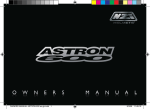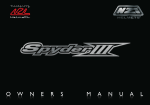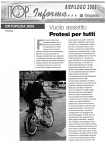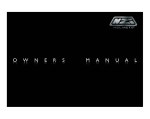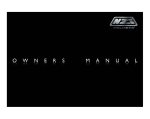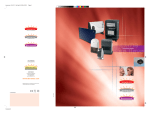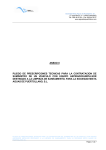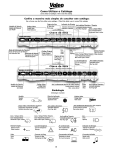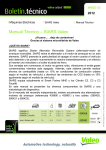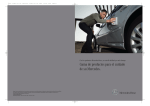Download Manual de usuario
Transcript
M A N U A L D E U S U A R I O Muchas gracias por la compra de este nuevo producto NZI. Para un mejor aprovechamiento de este casco, le recomendamos leer este manual de instrucciones. CONSEJOS PARA EL USO Y MANTENIMIENTO DEL CASCO Cuide su casco, protegerá su cabeza en caso de accidente. Este casco está provisto de una fina capa de pintura de acabado. Como cualquier superficie pintada, el maltrato y el descuido al transportarlo, como por ejemplo llevarlo sujeto al antirrobo de la moto, puede estropear el acabado. No modifique la estructura del casco. Nunca lo lance contra el suelo. Su casco está diseñado para absorber la energía del impacto mediante la destrucción parcial de algunos de sus componentes, si recibe un impacto violento, debe sustituirlo, aunque parezca intacto. Nunca deje el casco cerca de una fuente de calor. Temperaturas por encima de 50°C podrían dañar seriamente su casco. No aplique pinturas, adhesivos, combustibles o disolventes, pueden afectar a la estructura de la carcasa. CARACTERÍSTICAS Carcasa externa de composite de fibras pintada y lacada. Relleno protector multi-densidad. Sistema de retención con cierre micrométrico. Pantalla 3-D homologada “mist retardant”, (antivaho certificado ECE/ONU R22.05). Interior extraible y lavable. Ventilación múltiple. ES LA TALLA DEL CASCO Es importante escoger la talla adecuada del casco para que le proteja adecuadamente en caso de impacto. La talla viene determinada por el perímetro mayor del cráneo. Para saber cual es su talla rodee su cabeza por encima de los ojos y las orejas con una cinta métrica y obtendrá una medida en cm. 3 M A N U A L D E U S U A R I O (Fig. 1). Elija un casco de esa medida y si le aprieta demasiado escoja una talla superior. No olvide que el interior del casco cede con el uso. Si duda entre dos tallas elija la más ajustada. AJUSTE DEL CASCO Para ajustar el casco colóquelo en la cabeza y abróchese el cierre sin que quede holgura entre la correa y el mentón. El casco debe colocarse de forma que proteja la frente y la nuca correctamente. (Fig. 2). Nunca inclinarlo hacia atrás o hacia adelante. (Fig. 3 y 4). ES PANTALLA Las pantallas de los cascos NZI se fabrican termoformando la materia prima y están revestidas para resistir las rayaduras y la formación de vaho, evitando de esta manera que la visión y la seguridad queden comprometidas en situaciones críticas. Con este proceso productivo se aumenta la transparencia, resistencia a la rotura y a la abrasión. Las pantallas NZI “Mist Retardant” están homologadas según ECE/ONU R22.05 y tienen un alto grado de transmisión luminosa, reconocimiento fiel de las señales luminosas, buena transmisión espectral, baja difusión de la luz y calidad óptica. Normas para el cuidado de la pantalla. Limpiar con agua y jabón. Para secarla no 4 se debe frotar si no tan solo tamponar. Evite terminantemente el uso de alcohol, detergentes para vidrios o productos abrasivos. Le recomendamos cambiar la pantalla cuando aparezcan rayaduras o marcas por efecto del uso o desgaste que puedan dificultar la visión. Cambio de pantalla. Abra completamente la pantalla (fig.5 y 6). Tire del gatillo hacia abajo, ayúdese con una moneda si es necesario, y mueva nuevamente la pantalla más hacia arriba hasta que salga de su alojamiento (fig.7). Repita la operación en el otro lado. Montaje: Haga coincidir los salientes de la pantalla con los alojamientos del mecanismo marcado en la figura con un circulo. Presione la pantalla en la M A N U A L D E U S U A R I O zona marcada con una flecha en la figura 8. Gire la pantalla hacia abajo hasta oír un clic. Repita la operación en el otro lado de la pantalla. TAPICERÍA DESMONTABLE Su casco dispone de tapicería interior desmontable para su limpieza. Usted puede lavar la tapicería desmontable. Una vez desmontado el interior lavar a mano con jabón neutro dejando secar sin escurrir y sin exponer directamente a los rayos del sol. Cambio de tapicería. Desmontaje: Saque de su alojamiento la pieza de tapicería frontalsuperior. (Fig.9). Saque la pieza de la tapicería que la sujeta a la parte posterior. (Fig.10). Montaje: Encaje la parte frontal de la tapicería en su alojamiento y la parte posterior de la tapicería en su alojamiento. ES Almohadillas laterales. Su casco dispone de almohadillas laterales especialmente diseñadas para optimizar el confort y la estabilidad posicional del casco durante la conducción. Cambio de almohadillas. Desmontaje: Desmonte la almohadilla 5 M A N U A L D E U S U A R I O tirando de ella, con cuidado, por la parte trasera de esta y sacándola de su alojamiento (Fig.11). ¡Atención! Nunca desmonte la almohadilla tirando de su parte delantera, podría forzarla y romper el relleno de protección de esta. Montaje: Siga los pasos anteriores de manera inversa, teniendo en cuenta que primero debe encajar la parte delantera de la almohadilla en su alojamiento y después la posterior. ES Limpieza de las almohadillas. Usted puede lavar la funda tapizada de las almohadillas. Una vez desmontadas abra los cierres de velcro y retire la funda. Lavar a mano con jabón neutro dejando secar sin escurrir y sin exponer directamente a los rayos del sol. SISTEMA DE RETENCIÓN Su casco dispone de un sistema de retención que evita que el casco se desprenda de la cabeza en caso de accidente. Cierre micrométrico. Para cerrar: Introduzca el extremo dentado del cierre en el sistema de bloqueo hasta ajustar la correa de cierre al cuello. (Fig. 12). 6 Para abrir: Tire de la cinta roja del sistema de bloqueo hasta liberar el extremo dentado del cierre. (Fig. 13). SISTEMA DE VENTILACIÓN Su casco dispone de diferentes aberturas regulables y canalizaciones internas para la renovación del aire en el interior. Para regular el flujo de aire interno puede abrir o cerrar las ventilaciones tal como muestran las figuras 14 y 15. O W N E R S M A N U A L Congratulations for purchasing this new NZI product. In order to enjoy the best features of this helmet, we strongly recommend you to carefully read this instruction manual. ADVISE HOW TO USE AND MAINTAIN YOUR HELMET Take care of your helmet; it will protect you in case of a crash. This helmet has been finished with a thin paint coating. Just like any other painted surface rough handling or carelessness when using the helmet (like, for example, having the helmet fastened together with the lock) could damage this coating. Do not modify the main helmet structure. Do not throw it against the floor, nor expose your helmet to temperatures higher than 50ºC, because, besides damaging the paint coating, the level of protection of your helmet could decrease. Do not apply paints, self-adhesives, combustibles or solvents on your helmet, the degree of protection may diminish. HELMET SIZE It is important to choose the correct helmet size, so that it will protect you adequately in case of an impact. The helmet size is determined by the largest perimeter of the skull. Surround your head with a measure tape, just above the eyes and ears, and you will obtain a measure in centimetres (Fig. 1). Choose a helmet that corresponds to this size, and if the helmet is too tight, opt for a larger size. Please do not forget that the helmet interior stretches when being used. If you hesitate between two sizes, opt for the smaller one. GB SPECIFICATIONS Composite external shell, painted and varnished; multi-density protection liner; chin strap with micrometric quick release; 3-D thermoformed visor with “mist retardant” ECE/UN R22.05 homologated anti-mist properties; multiple ventilation, detachable and washable interior. 7 O W N E R S M A N U A L PUTTING THE HELMET ON To put the helmet on correctly, place it onto your head and fasten the chinstrap without leaving any clearance between the strap and the chin. The helmet should be placed on your head in such a way that it protects both the forehead and neck (Fig. 2). Do not incline the helmet forwards or backwards (Fig. 3 & 4). GB VISOR NZI visors are made by thermoforming raw material that is already completely coated with an anti-scratch and “mist-retardant” treatment; these coatings avoid loss of vision and enhance safety in critical situations. By using the thermoforming process flexibility, transparency, scratch resistance and abrasion resistance are increased. NZI “mist retardant” visors are ECE/ONU R22.05 homologated; having high light transmission, accurate luminous road sign recognition, good spectral transmission, low light diffusion and good optical quality. Instructions for taking care of your visor. Clean the visor only with water and neutral soap. To dry the visor it is not necessary to rub; dabbing will do. We strongly recommend you to avoid the use of any kind of solvents, alcohol or abrasive products on the visor. It is recommended to replace the visor when scratches or marks appear during the use; 8 they can impair your view. Replacing the visor. Removal: Fully open the shield (see figure 5 and 6). Push the clamp downwards (use a coin if necessary), and move the shield further upwards until it is released from the mechanism (figure 7). Repeat these steps for the other side. Assembly: Make the outstanding parts of the shield coincide with the positions of the mechanism, which are marked with a circle in figure 8. Put pressure on the shield at the position marked by an arrow. Turn the shield downwards until you hear a “click”. Repeat these steps for the other side. O W N E R S M A N U A L COMFORT LINER Your helmet has detachable comfort liner. You can easily take it out and clean it. Wash it by hand with neutral soap, don’t wring it out and avoid exposing it to direct sunlight while letting it dry. Comfort liner replacement. Removal: It is recommended to remove the cheek pads first. Pull the frontal part of the liner out of its slot (Fig. 9); then pull the rear part out of its slot (Fig.10). Assembly: It is recommended to remove the cheek pads first. Insert the frontal part of the comfort liner into its slot; then insert the rear part of the comfort padding into its slot. If necessary, use a flat screwdriver (carefully). Side cheek pads. Your helmet has especially designed cheek pads to optimize comfort and the positional stability of the helmet while riding. GB Replacing the cheek pads. Removal: Gently pull out the cheek pad by its rear part (Fig.11). Attention! Never pull at the front part, by doing this you can apply to much force and break the inner protective liner. 9 O W N E R S Mounting: Insert the front part of the cheek pad in its place; then push the rear part into its place. Cheek pad cleaning. You can wash the comfort liner of the cheek pads. Detach the Velcro and take the comfort liner of. Wash it by hand with neutral soap, don’t wring it out and avoid exposing it to direct sunlight while letting it dry. GB RETENTION SYSTEM This helmet has a retention system that prevents the helmet flying of your head in case of an accident. Micrometric quick release. Closing: Slide the toothed part into the buckle until there is no more room in between the chinstrap and your chin (Fig.12). Opening: Pull the red strap on the buckle until the toothed part of the quick release is completely free (Fig.13). VENTILATION SYSTEM This helmet has several air intakes and inner ventilation channels that assure a good air renovation inside. In order to adjust the inner air flow you can open and close the air intakes as shown in Fig. 14 and 15. 10 M A N U A L












